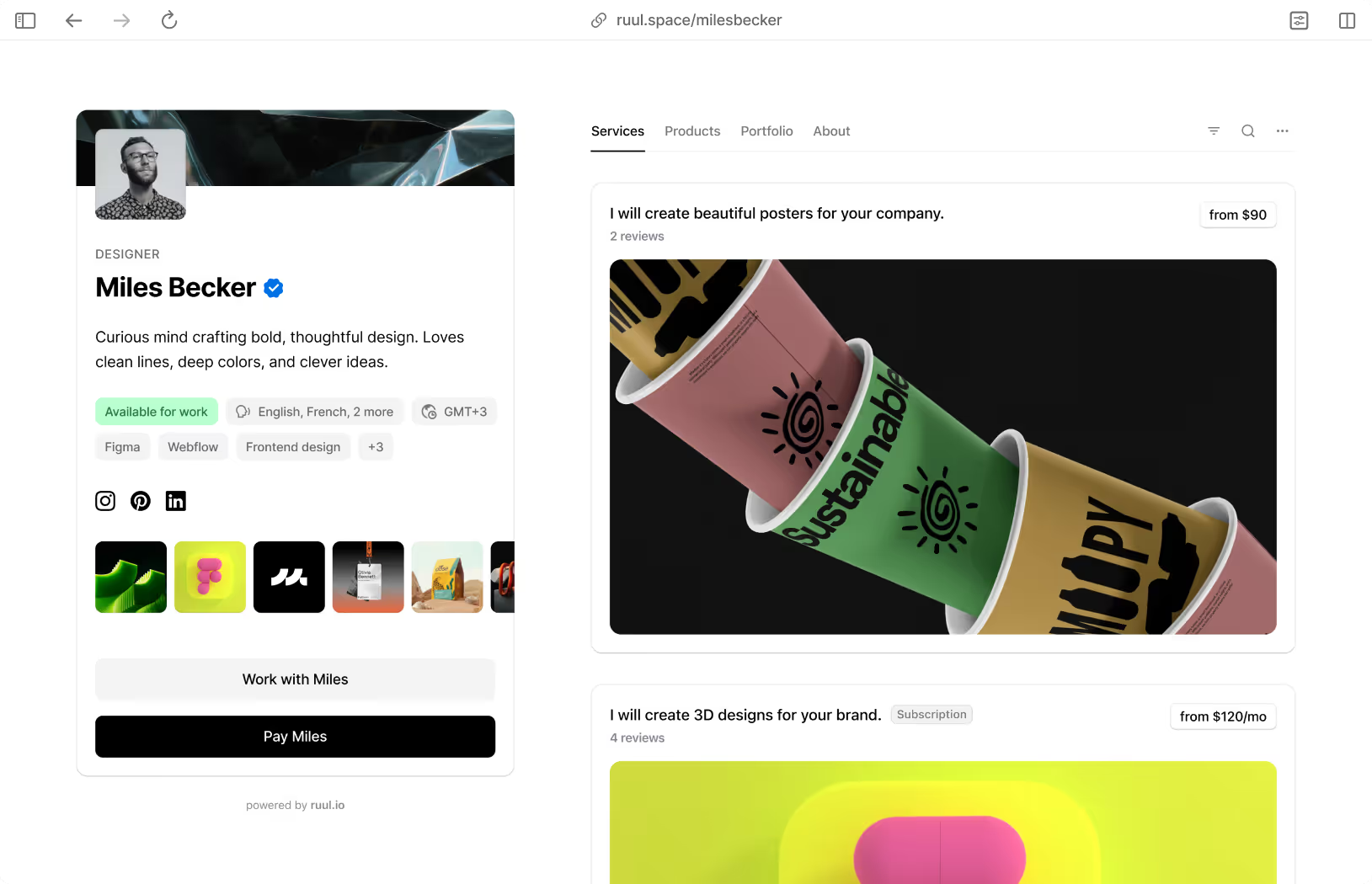Remember the early days of your professional life when you were often reminded how important your CV was? Well, people who said it were right, and believe it or not, whether you build it from scratch or use a freelance portfolio template, a comprehensive and neat freelance portfolio is equally important. In some cases it is even more important than your CV which only demonstrates your formal work experience.Being a freelance writer is equally challenging and rewarding. While it grants you a great deal of personal freedom it also requires you to be a responsible professional with competent self-management skills. Whatever sub-type of freelance writing you are interested in, you can always use a good pitch.Preparing a freelancing portfolio is a great way to demonstrate your technical skills,soft skills, the type of work you do, and most crucially the previous works you performed. Your freelancer portfolio is what sets you apart from your competitors and represents you in the market.Contrary to a conventional CV or a resumé, your self-employed portfolio gives you more space and freedom in terms of what message you want to convey to future clients while looking for potential freelance projects.Plus, putting freelance work on your portfolio coupled with other, more personal traits can create a sense of sincerity and acquaintanceship among your future clients. We are sure that this article has something to offer you whether you are a new freelancer wondering how to list your self-employment experience on your portfolio, or an experienced one targeting to improve your freelance writer portfolio.
What is a writing portfolio?
Basically, a writing portfolio is a portfolio where you demonstrate both your writing skills and your previous experience in freelance jobs related to writing. The purpose of preparing a writing portfolio is to demonstrate your relevant experience and freelance gigs you accomplished, and to inform your future clients as well as other freelancers about your job description.Depending on your needs and preferences, you can choose to use a portfolio template or not. But here, the absolute thing to keep in mind is that with the help of a template or not, your portfolio should include some essential items and it should be organized in an easily understandable and ‘user friendly’ way.Next, we’ll give you some ideas concerning how to add freelance work to your portfolio while remaining loyal to the essentials.
Characteristics of a strong writing portfolio
It takes a bunch of fundamental elements to make a writing portfolio strong. Let’s go over the essential characteristics of a bulletproof freelance writer portfolio.
Keep the ultimate purpose of a writing portfolio in mind
Always keep in mind that you are creating the writing portfolio with a vision which is to make these points evident:
- your improvements,
- your skills
- your achievements.
Choose a design that’s easy to navigate and understand
Your portfolio should bring the nuts and bolts of your freelance work together, consisting of:
- your previous experience
- your area of expertise
- your writing skills
- the outlets where your work is put (such as websites)
Differentiate between your in progress and completed projects
You may be currently working on an exciting project and think that it deserves to be displayed on your portfolio. Go for it! However, make sure you display the distinction between ongoing projects and the freelancer jobs and projects that you completed so far.
Decide on which works to highlight
Usually clients don’t have time to go over an entire collection of writing. Instead of listing all work you accomplished, you can find a way to curate some examples from different types of work you do and the services you offer.
How to build a writing portfolio in 8 steps
Until this point we mostly covered preparing a portfolio for writers who work for freelance jobs. But the thing is, whether you want to prepare a freelance journalist portfolio, freelance editor portfolio or a freelance writer portfolio, the basics are all the same.Once you understand the underlying logic of building a good portfolio, you can adjust it according to the specifics of the sector. So here are 8 easy steps to take while building a writing or any other type of portfolio. By providing these steps, we’ll also be answering the question on how to add your independent contractor work on a portfolio:
- Pinpoint and understand your target clients
- Exemplify your skills and highlight what you are good at
- Include the best of the best when it comes to your work
- Use a writing portfolio app or a website
- Update your portfolio regularly
- Decide the domain and the place where you want to display your portfolio
- Seek out guest posts
- Reach clients and do some networking
Identify your potential clients
Here is the first thing we need to get straight: we can’t address anyone and everyone. Like they used to say in the television business: you need to reach out to your ‘target audience’. In order to achieve this you should be able to assess:
- who your potential clients are
- what they are looking for
- what the current trends in your field are
It’s easier to properly build the suitable portfolio once you know who you are in dialogue with.At times when you feel like you are experiencing hardships building a portfolio that suits your clients, you can try examining some samples of freelance writer portfolios. Good examples of writer portfolios can prove inspiring.
Define your skills and find your niche
Since the activity of writing is often described with a single word, it is usually thought of as an all-encompassing endeavor. But as all freelancers know, the reality is quite more complicated than that.To that end, it is meaningful to define the skills that you put on a job application as well as on your portfolio. Try illustrating and elaborating your particular skills regarding specific writing tasks. Find and underline what you are especially good at (your niche, so to speak) in order to make a good impression on your future clients.
Only include your finest work
Everything moves at lightning speed in today’s business world, hence clients often have to make quick decisions about who to work with in their projects and take action accordingly. This means that you may not have enough space to feature every goal you accomplished so far in your portfolio.Building your portfolio by being mindful about this fact will give you a running start. You should only include what you believe to be your finest work in order to increase your chances. Including your best projects makes you look more professional and expresses the message that you are 100% fit to get the job done.
Select a writing portfolio app or website to showcase your samples
Thanks to the era of technology we are living in, it is possible to benefit from apps and websites designed to build writing portfolios. Such apps and websites are great because they help us save a considerable amount of time–they put everything together neatly and most of them offer free options. Needless to say, with the help of such apps and websites you can easily illustrate and highlight what you want to put in the forefront.Portfoliobox, Krop, Cargo, Adobe Portfolio, Weebly, Wix and IM Creator can be listed as some of the best portfolio building platforms. Many of those platforms offer free options and affordable packages for individuals and companies. Such platforms are also pretty handy with templates, dashboards, large storage units and customization options.
Update and review your digital portfolio regularly
At some point in our career, many of us build a portfolio or prepare a CV, and hardly ever look at it again unless we have to. This approach is not always useful. As we gain experience, the bulk of projects we complete and the tasks we wrap up increase gradually.Instead of reviewing and updating your digital portfolio once in a while when you feel like it, try turning it into a regular habit to review and update your digital portfolio on a consistent basis.Do you recall how we suggested always including your finest work in your portfolio? That step and this one go perfectly together. As you continue working, you’ll gradually complete finer and finer tasks and get better at what you are doing. By updating your digital portfolio regularly, you actually distill your portfolio into a first-rate state and omit the self-employed jobs of secondary importance.
Decide on a domain name and where to host your portfolio
Up to this point we talked about how to build a strong portfolio and tips for building it. But you should also keep in mind that building a portfolio is only 50% of the entire enterprise.The other 50% is to spread the word and make your portfolio get views from potential clients. If we are talking about ensuring this through digital channels, the best method is to decide on a domain name first. After you decide on the domain name and where you want to host your portfolio the next step is to display it on the relevant outlet.As mentioned above, it is better to focus on one domain or two at maximum to host your portfolio. This will allow you to center your energy to that one or two sites and aim for quality over quantity.
Seek out guest post or non-profit opportunities
Perhaps one of the most challenging parts of getting into freelance writing projects, or more generally in any freelance project, is to get started and be acknowledged by people who have already established a firm position in the field. But this shouldn’t be too frightening and discourage you from doing what you intend to do.On the contrary, remember that people who you admire today and look up to were probably in your shoes once. The solution for not having enough experience is actually fairly simple. You can chase minor gigs and guest post opportunities at the beginning. Similarly, you can write for NGOs (non-governmental organizations) or volunteer for multiple NGOs to get their writing tasks done.This way, you can familiarize yourself with the freelance writing process and you can build connections. At the end of these tasks, which generally tend to be less demanding, you can have the founding blocks of your professional portfolio.
Reach the clients you need to launch your writing career
Sitting around and waiting for clients to come to you is one way of handling your network. But the active pursuit of reaching out to clients who may be looking for someone with your abilities and skills is probably a better way to get started. Unfortunately, this point is often a little misunderstood. Freelancers who are new to the business sometimes tend to think that there is one single place or a magic formula to reach clients.However, the truth is that clients can be found in endless ways from even the most unthinkable of places. A few steps you can take include:
- Informing your friends
- Using the power of the internet efficiently
- Joining online or face to face community and networking meetings
- Promoting yourself and your work on social media
Once you make up your mind on finding clients, the possibilities are plentiful.We have tried to walk you through the steps to build a bulletproof freelance writer portfolio displaying your range of writing skills and different types of work you have completed. For more tips and think pieces on pursuing a solo career as a freelance writer or journalist, feel free to dive into our blog!







.avif)


